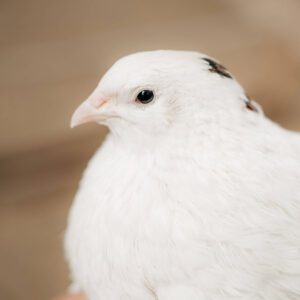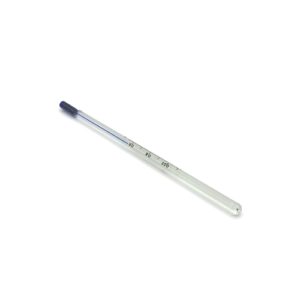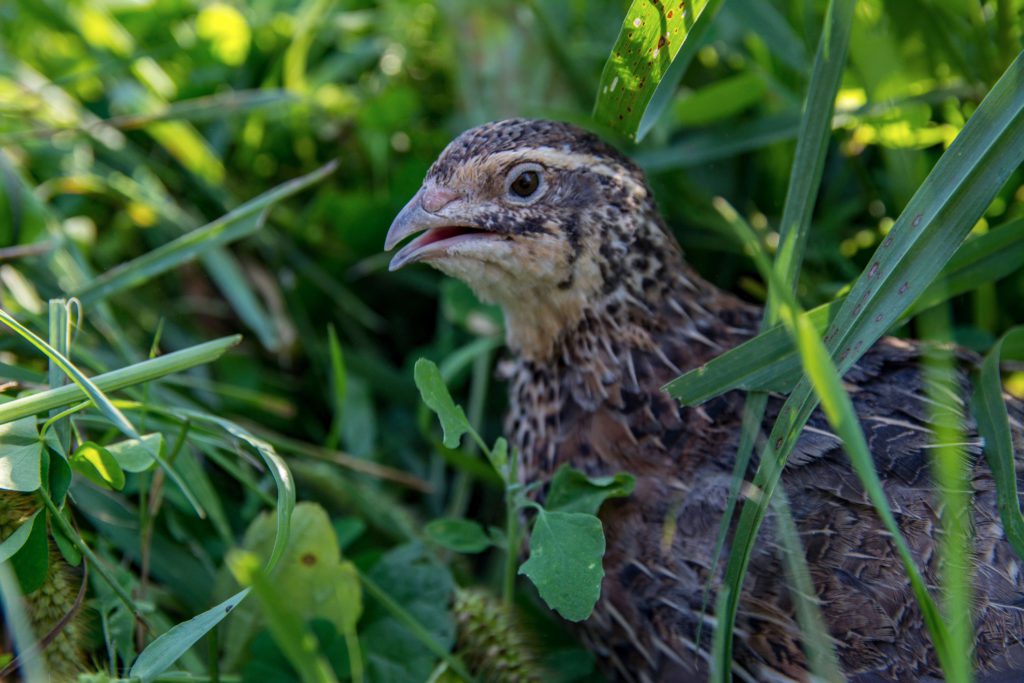As more and more people become disillusioned with factory farm poultry due to the poor quality of meat, unhealthy chemical additives, and the continuously increasing prices they are increasingly turning to more sustainable options. One of the most sustainable and efficient options is raising coturnix quail. These birds are fantastic options for both meat and eggs, and they are much easier to raise than other poultry. Here’s what you need to know if you want to raise coturnix quail yourself.
What are Coturnix Quail?
Coturnix quail are a species of quail that is native to East Asia. They are also known as Japanese quail, Chinese quail, or Pharaoh quail. These birds are the most common type of domestic quail and have become incredibly popular among homesteaders.
Standard Coturnix weigh 4-6 ounces at maturity, Jumbo Coturnix quail average 8-10 ounces at maturity, and with extended selective breeding Jumbos can weigh more than 14 ounces when fully mature. Coturnix can live more than 4 years, however most Jumbos and selectively bred large coturnix average 1-2 years of service in egg laying.
They come in a variety of plumage colors and patterns. Coloring can include dark brown, black, white, gray and many more. The most common color/pattern is brown coloring and “wild” pattern pictured above. This color and pattern is often referred to as “Pharaoh”, “Brown”, or “Wild”.
They are one of the easiest birds to raise, making them perfect for novices of the backyard coop world.
Why Raise Coturnix Quail?
If you’re looking to raise your own sustainable livestock for food, here are some fantastic reasons to choose the coturnix quail.
Coturnix Quail for Meat
The meat you can get from coturnix quail is a real delicacy with a tender consistency and taste that is close to chicken, but with far more flavor. It’s also incredibly nutritious with a high protein ratio as well as an impressive Vitamin C, B6 and Iron content.
It’s not uncommon to see quail featured on the menus of high end restaurants due to its unique taste palette (though it isn’t gamey) and it’s even one of Gordon Ramsey’s featured recipes.
Coturnix Quail for Eggs
It’s not just great meat you can expect, because the quail eggs are fantastic too. Coturnix quail can lay 300+ eggs per year which means you’ll have a regular supply of these little delicacies! The eggs have a hard shell and a wonderful flavor that’s often compared to a chicken egg but with a much richer taste. In fact, many people prefer the taste of quail eggs to chicken eggs, as our family does! If you keep your hens with a rooster, you have an unlimited supply of quail hatching eggs for sale or to incubate.
Small Size
The smaller stature of coturnix quail makes them much more efficient than chickens. They don’t require as much food and they produce significantly less waste. This means that you can save money on their feed bill as well as having less manure to deal with (although it can create a great fertilizer).
Low Maintenance
Coturnix quail are very low maintenance birds that are easy to take care of. They don’t need a lot of space and they can even be raised in your backyard, garage, or balcony. They are also, typically very quiet birds which is a big part of why they have become popular for urban and suburban homesteads.
Fast Maturity
One of the biggest advantages of raising coturnix quail is that they mature very quickly. In just 10 weeks these birds are fully grown. In 6 weeks from hatching they are mature and are laying eggs or ready to slaughter. This means you can have a regular and sustainable supply of meat and eggs in no time at all.
Short Lifespan
Coturnix quail typically only live up to 4 years (may differ by breed or bloodlines), which is a much shorter lifespan than other poultry. This means that you will need to turn over your flock and replace your laying quail to get a constant supply of fresh quail eggs. Additionally, there is a much lower risk of disease and sickness since they don’t live long enough to develop these problems.
Highly Adaptable
Coturnix quail are very adaptable birds that can thrive in a variety of different climates. This makes them perfect for homesteaders that want to raise their own quail but don’t have the ideal conditions. Adults can withstand both hot and cold climates with ease so you can be comfortable in the knowledge that your coop will thrive.
Resilient
Once they reach maturity, adult quail are incredibly resistant to disease and parasites. Quail Chicks on the other hand can be prone to cold and other concerns, so they require a bit more special care until they are feathered (3 weeks).
Highly Sustainable
In an effort to combat inflation and supply chain shortages, many people have turned to Coturnix quail to provide a consistent supply of healthy meat and eggs. Coturnix quail are the perfect option for those that want to take control of their food supply in any situation. Not only are they small, efficient birds to raise, their eggs can be easily collected and incubated to grow or replenish the Coturnix Quail Flock.
Raising Coturnix Quail vs Chickens
Here are some direct comparisons between raising coturnix quail and chickens.
Time to first eggs: Quails (6-8 weeks), Chickens (18 weeks)
Size: Coturnix Quails (6-14 ounces), Chickens (4-6 pounds)
Space Required: Adult Quails (0.5-1 square feet per bird), Chickens (4 square feet per bird)
Noise: Quails (low), Chickens (medium to high)
Average Egg Production: Quails (200-300 eggs per year), Chickens (150-250 eggs per year)
Time to hatch eggs: Quails (17 days), Chickens (21 days)
What do You Need to Raise Coturnix Quail?
As we’ve mentioned already, quail require far less space than other poultry like ducks and chickens. In fact, you can easily raise Coturnix quail on your deck or your balcony without taking up too much space.
Although, it it sometimes difficult to locate Coturnix Quail for Sale, they can be found locally of for sale online. Try Craigslist, Facebook Groups, or searching online for Live Quail for Sale. If you are unable to locate jumbo coturnix quail for sale, you can definitely find quail hatching eggs for sale online.
Raising Coturnix Quail for Meat
If meat is the primary focus for your quail, then you want to ensure they fatten up as much as possible. Avoid free ranging your birds and allowing them to get too much exercise. You may even want to consider limiting their movement or keeping them in the dark for the last week or 2 prior to slaughter. While quail are omnivores, they do prefer seeds, grains, and insects. So, a diet rich in these things will help them to put on weight.
Raising Coturnix Quail for Eggs
Raising quail for eggs is actually a pretty simple process. Unlike other birds, quail can lay eggs just about anywhere and don’t need specific nesting boxes. Though unlike meat focused quail, you don’t want to keep them in the dark as this will lead to less quail eggs. Finally, to promote egg production, ensure you use a feed with plenty of calcium as this is ideal for a hen’s diet. You can also have your own supply of fertile quail eggs to hatch as needed to replace or grow your flock.
Summary
Hopefully now it’s case closed when it comes to coturnix quail vs other poultry. These amazing little birds are not only highly sustainable but also require far less space and effort than other options. So, if you’re looking for a way to produce your own delicious meat and eggs in an sustainable way, then raising coturnix quail is the perfect solution!
Start Your Own Quail Flock Today with Our Quail Hatching Eggs
-
Product on sale
 Jumbo White Coturnix Quail Hatching Eggs x 15Original price was: $37.49.$32.99Current price is: $32.99.
Jumbo White Coturnix Quail Hatching Eggs x 15Original price was: $37.49.$32.99Current price is: $32.99. -
Product on sale
 Jumbo White Coturnix Quail Hatching Eggs x 30Original price was: $71.99.$62.99Current price is: $62.99.
Jumbo White Coturnix Quail Hatching Eggs x 30Original price was: $71.99.$62.99Current price is: $62.99. -
 Incubator Thermometer – Brinsea Liquid in Glass Thermometer$19.99
Incubator Thermometer – Brinsea Liquid in Glass Thermometer$19.99 -
Product on sale
 Jumbo White Coturnix Quail Hatching Eggs x 50Original price was: $114.99.$99.99Current price is: $99.99.
Jumbo White Coturnix Quail Hatching Eggs x 50Original price was: $114.99.$99.99Current price is: $99.99. -
 Incu-bright Egg Candler$27.99
Incu-bright Egg Candler$27.99 -
Product on sale
 Jumbo White Coturnix Quail Hatching Eggs x 150Original price was: $299.99.$269.99Current price is: $269.99.
Jumbo White Coturnix Quail Hatching Eggs x 150Original price was: $299.99.$269.99Current price is: $269.99.

Hey do ya have any suggestions for feed?
Hi there,
A Gamebird Starter feed is needed until 6-10 weeks of age. We use it through 8 weeks of age, then change to a gamebird layer feed
If you are breeding quail for eggs, you will need a high protein feed that also provides calcium. The simplest way is to mix a gamebird starter crumble with a layer crumble, as there are not many gamebird layer feeds available.
For adult laying hens you are targeting 18%-22% protein and 1.5%-3.5% calcium.